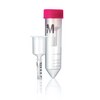A novel tetrodotoxin-sensitive, voltage-gated sodium channel expressed in rat and human dorsal root ganglia.
Sangameswaran, L, et al.
J. Biol. Chem., 272: 14805-9 (1997)
1997
Show Abstract
Dorsal root ganglion neurons express a wide repertoire of sodium channels with different properties. Here, we report the cloning from rat, dorsal root ganglia (DRG), cellular expression, and functional analysis of a novel tetrodotoxin-sensitive peripheral sodium channel (PN), PN1. PN1 mRNA is expressed in many different tissues. Within the rat DRG, both the mRNA and PN1-like immunoreactivity are present in small and large neurons. The abundance of sodium channel mRNAs in rat DRG is rBI > PN1 >/= PN3 >> rBIII by quantitative reverse transcription-polymerase chain reaction analysis. Data from reverse transcription-polymerase chain reaction and sequence analyses of human DRG and other human tissues suggest that rat PN1 is an ortholog of the human neuroendocrine channel. In Xenopus oocytes, PN1 exhibits kinetics that are similar to rBIIa sodium currents and is inhibited by tetrodotoxin with an IC50 of 4.3 +/- 0.92 nM. Unlike rBIIa, the inactivation kinetics of PN1 are not accelerated by the coexpression of the beta-subunits. | 9169448
 |
Identification of PN1, a predominant voltage-dependent sodium channel expressed principally in peripheral neurons.
Toledo-Aral, J J, et al.
Proc. Natl. Acad. Sci. U.S.A., 94: 1527-32 (1997)
1997
Show Abstract
Membrane excitability in different tissues is due, in large part, to the selective expression of distinct genes encoding the voltage-dependent sodium channel. Although the predominant sodium channels in brain, skeletal muscle, and cardiac muscle have been identified, the major sodium channel types responsible for excitability within the peripheral nervous system have remained elusive. We now describe the deduced primary structure of a sodium channel, peripheral nerve type 1 (PN1), which is expressed at high levels throughout the peripheral nervous system and is targeted to nerve terminals of cultured dorsal root ganglion neurons. Studies using cultured PC12 cells indicate that both expression and targeting of PN1 is induced by treatment of the cells with nerve growth factor. The preferential localization suggests that the PN1 sodium channel plays a specific role in nerve excitability. | 9037087
 |
Structure and functional expression of a new member of the tetrodotoxin-sensitive voltage-activated sodium channel family from human neuroendocrine cells.
Klugbauer, N, et al.
EMBO J., 14: 1084-90 (1995)
1995
Show Abstract
A member of a new subclass of the voltage-activated sodium channel genes has been cloned from the human medullary thyroid carcinoma (hMTC) cell line. The cDNA of hNE-Na (human neuroendocrine sodium channel) encodes a 1977 amino acid protein which phylogenetically represents a link between sodium channels isolated from skeletal muscle and brain. The hNE-Na alpha subunit was transiently expressed in human embryonic kidney cells either alone or in combination with the human sodium channel beta 1 subunit. The channel exhibited rapid activation and inactivation kinetics, and was blocked by tetrodotoxin and cadmium with IC50 values of 24.5 nM and 1.1 mM, respectively. Action potentials were generated in cells expressing high levels of hNE-Na. Northern blot and reverse transcription-polymerase chain reaction (RT-PCR) analyses demonstrated its expression in hMTC cells, in a C-cell carcinoma, and in thyroid and adrenal gland. Transcripts were not identified in pituitary gland, brain, heart, liver or kidney, indicating that the hNE-Na is a sodium channel solely expressed in neuroendocrine cells. | 7720699
 |


















